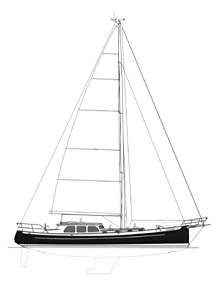Perry 53-foot MS
Motorsailer
I was having a quiet dinner with Laurie Davidson in Auckland, New Zealand, enjoying the local whitebait fritters along with some excellent local Savignon Blancs. We were having a good time talking about boats and people. Then Laurie mentioned that he had seen a review in SAILING of one of my own designs, a big double-ender. I told him that, yes, that was the Shrontz boat. All excited, I asked him what he thought of it.
"I thought it was bloody awful" he blurted. "I pulled out a piece of sketch paper, laid it over the drawing in SAILING and drew a new bow on the boat and my bow improved the boat immensely." Laurie appeared happy with himself and his choice of sav blanc. I thought the wine tasted a little bitter.
This new design of mine is for an East Coast client with a love of traditional old boats. When we began this project he sent me a book to illustrate his ideas of what a beautiful boat should be. He likes stalwart traditional craft that almost border on workboat traditions. This new boat makes a stark contrast with the yacht styling of Paine's Morris 46. Ironically, this new motorsailer will be built in Maine at Lyman-Morse.
The plumb bow came from another design of mine, the one Laurie had mentioned. Despite Laurie's criticism of this shape, I am using it again. I think it fits the look and buys us a lot of DWL. Compare this boat to the Morris. The DWL of the Morris is 34 feet, 6 inches while my motorsailer at 53 feet has a DWL of 49.42 feet. That gives the Morris a hull speed of 7.9 knots and my 53-footer a hull speed of 9.5 knots using a speed-to-length ratio of 1.35. But my boat is not only about boat speed. It's also about creating a vintage look, which is why the boat is a double-ender and has a plumb stem. In fact, if you look very carefully you'll see this stem actually curves back, beyond plumb. I admit, it's a strong look. I love big, bold and earthy cabernets, too.
The L/B is 3.58 and the D/L is 203. We are using a modern fin-and-bulb-type keel and a semibalanced spade rudder with a carbon stock. Given that we chose the double-ended hull form for aesthetics we have done what we could with this hull to ensure excellent speed under sail. My hope is for a wolf in sheep's clothing. I also like lamb.
There was never any intention of filling this entire hull with accommodations. That would have put pressure on the aesthetics that would have compromised the overall look of the boat. The layout features two staterooms with the owner's forward. There are two heads and the owner's head is all the way forward with a big shower stall. The pilothouse has a large dinette raised so you can see comfortably out the big windows. The galley is sunken to extend the counter and lockers outboard under the side deck. The steering station is in the aft starboard corner. It's unusual to put the pilot station aft but it works and allows us to line up the settee with the dinette.
The rig is big for a motorsailer with a SA/D of 17.89. The working jib will be self-tacking and the mainsail will be on a Leisure Furl boom. A self-tacking staysail will be used for heavy air. Note on the profile that the pilothouse top extends aft of the aft bulkhead to allow for some sheltered seating in the cockpit. Wide side decks and a small overall cabintrunk should add to the vintage look of this boat.
When the client and I started this project the idea was to try to have some fun with it. Make a real distinct design statement. Do a boat you would never see at a boat show. That's what custom boats are all about.

Comments